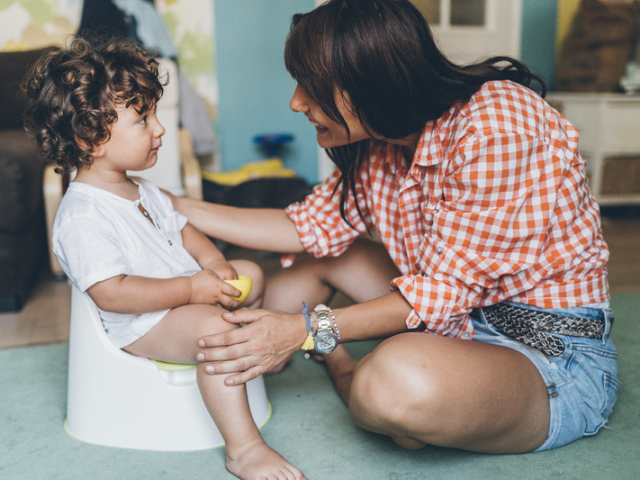Potty training a child is difficult under any circumstances. You will need to consider your child’s abilities and delays before you can begin potty training. This may initially seem daunting, but if you take time and prepare your child, you can succeed in potty training!
A few signs will let you know that your child is physically ready for potty training. For normally developing children, this usually happens between the ages of 2 and slightly after their 3rd birthday. But it’s important to remember that every child moves at their own pace, and forcing potty training on a child who isn’t developmentally ready will be a waste of time. It will be a terrible experience for you and your child. If your child is not showing signs by three years old, begin the process anyway. Beforehand, consult your child’s physician to rule out any medical issues that may hinder the process.
Communication is probably one of the biggest difficulties in teaching a child to use the toilet. If your child is physically ready and, for the most part, developmentally ready, but they can’t verbally tell you when they need to use the potty, then how will you ever know? Trying to anticipate their needs without communication would be difficult at best and most certainly would lead to quite a few unintended accidents.
Ideas to Help with Communication Problems During Potty Training
Use Sign Language
You may be able to teach your child some simple signs like diaper or potty. When it’s time to start potty training and your child is not using much functional language, your child could sign when the diaper needs changing or when it’s time to sit on the potty.
Use Tangible Symbols
If your child doesn’t have the coordination for signs, you may want to try using tangible symbols. Keep these symbols handy, so your child can communicate their need to use the potty by simply touching the symbol. A good symbol for the bathroom is a piece of remnant tile. Most bathrooms have tile somewhere, which will feel reminiscent of the toilet itself.
How will you know when your child is developmentally and physically ready for potty training?
Signs Your Child is Ready for Potty Training
- Your child can follow 2-step instructions.
- Your child can communicate a need to go.
- Your child can imitate others.
- Your child is willing to cooperate.
- Your child shows a need to be independent.
- Your child can get to and from the toilet independently.
- Your child is aware of wet or soiled diapers.
- Your child can pull pants down and maybe even up.
- Your child can sit on the potty for 5 minutes without help.
Of course, not all kids will be able to do all these things, but you should have a good feeling that your child is on the right track developmentally to handle potty training. If you feel your child is physically and developmentally ready to begin potty training, it’s time to start.
Potty Training Methods and Tools
Prepare Yourself
Be sure to choose the right time to begin the toilet training process. Some possibilities are weekends or stay-at-home vacations when you can be fully committed without distractions. When your child is sick or being weaned off, the pacifier or naptime may not be the best time to introduce a new skill.
Organize a meeting with your spouse and your child’s caregivers, teachers, and therapists to brief them so everyone can follow the same protocol. The key to successful toilet training for your child is consistency. Most importantly, be relaxed and confident in your ability to train your child to use the bathroom independently. If your child senses you are anxious, chances are they will be more resistant and non-compliant.
Also, prepare for possible changes in your child’s behavior or mood when the toilet training process begins. Be extra patient and focus on fun activities during downtime.
Prepare Your Child
These are all skills your child will need to be familiar with during the actual toilet training process, so give them a head start by preparing them early:
- Keep the bathroom door open and let your child explore.
- Have your child watch members of the family go to the bathroom.
- Allow your child to see eliminations in the toilet.
- Allow your child to experience flushing.
- Read books about toilet training that have clear and relevant pictures.
- Show your child videos about toilet training (i.e., the Elmo video).
- If you buy a small potty, place it in the play area and use your child’s favorite dolls or animals to act out the toileting process.
- Teach your child the language associated with toilet training (e.g., “pee-pee” or “I need the potty”).
NOTE: Use sign language or symbols if your child is not talking. This is important so that your child learns how to request the potty on their own, a skill that may be very difficult and may come much later in the process for children with developmental delays.
Prepare the Environment
- Roll up area rugs.
- Block off areas that are “off limits” during toilet training (carpeted areas, couches, etc.).
- Remove stuffed animals and books if you don’t want them to get soiled.
- Cover fully carpeted areas with plastic sheets or shower curtain liners.
- Keep dry towels and disinfecting wipes handy for easier cleaning in case of accidents.
What to Buy to Help with Potty Training
- Many pairs of underwear (medium shades of blue and gray are the best because you can immediately see when they are wet!)
- Modified potty (optional)
- Step stool (to place in front of toilet if needed)
- Wet wipes
- Digital timer with alarm sound (child should hear it)
Reinforcement is Key
Rewarding your child for successful eliminations in the toilet is an essential part of the process. Helping him or her learn the correct steps will build your child’s confidence. The key is choosing a reinforcing item that your child can have ONLY when successfully eliminating in the toilet.
Choose perishable items (snacks, drinks) and give your child a small piece or sip, so they are highly motivated to get more. Repetition over time will teach your child the toilet training contingency: If you eliminate in the toilet, you get special treats! Make sure to give the reinforcing item directly after elimination to teach this connection quickly. You can do this by keeping the item in a clear bag in the bathroom cabinet or very close to the bathroom, out of the child’s reach.
It is also important to pair these treats with social praise (“Great job making pee-pee on the potty!!”) because you will eventually be able to fade out the reinforcing item and provide more natural, social praise when your child eliminates on the toilet. Calling your child’s favorite family member to boast of the good news may also serve as a highly effective reinforcer.
Final Note
Good luck with your potty training, and remember that this is an adventure for you and your child. It won’t be easy, and there will be many accidents along the way, but the reward is worth it!



